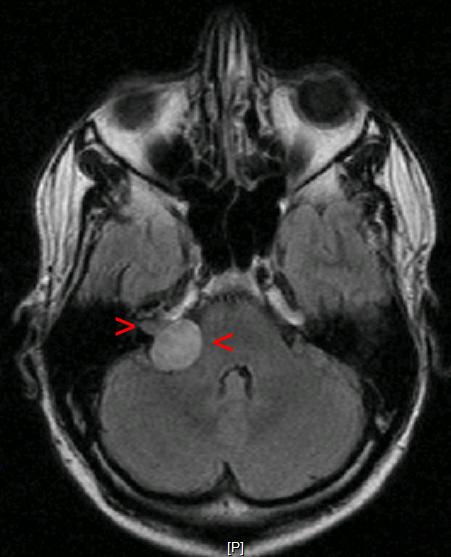Patient will present as → a 42-year-old male with a history of neurofibromatosis type II, complaining of nausea, vomiting, headache, continuous disequilibrium, and a slowly progressive unilateral hearing loss in his right ear. On physical exam, the patient has decreased sensation to touch on the right side of his face. An MRI is performed, with results seen here.
An acoustic neuroma (a.k.a. vestibular schwannoma) is a benign tumor of the Schwann cells (the cells which produce myelin sheath) – most commonly affects the vestibular division of the 8'th cranial nerve
- Patients will present with insidious unilateral hearing loss, tinnitus, headache, facial numbness, continuous disequilibrium
- Increased incidence in patients with neurofibromatosis type II
- Unilateral hearing loss +/- vertigo
Definitive diagnosis is by MRI (Gold standard)
- An audiogram is the first test done during a physical examination to diagnose acoustic neuroma. It usually reveals an asymmetric sensorineural hearing loss and a greater impairment of speech discrimination than would be expected for the degree of hearing loss
- Such findings indicate the need for imaging tests, preferably gadolinium-enhanced MRI
Small or non-growing tumors can be observed with serial MRI scans
- Stereotactic radiation therapy tends to be used for patients who are elderly, those with smaller tumors, or those who cannot undergo surgery for medical reasons.
- Microsurgery can involve a hearing-preservation approach (middle cranial fossa or retrosigmoid approach) or a translabyrinthine approach if there is no useful residual hearing.
Question 1 |
A 55-year-old male presents with progressive unilateral left-sided hearing loss over the past two months. He reports difficulty in understanding speech, though he can perceive sounds. Additionally, he mentions occasional imbalance, which he initially attributed to multitasking. Considering the possibility of an acoustic neuroma, what pattern of findings is most likely on audiometric testing?
Rinne test: Air conduction (AC) greater than bone conduction (BC) in both ears; Weber test: Lateralizes to the left Hint: Rinne showing AC > BC in both ears with Weber lateralizing to the left would suggest conductive hearing loss in the left ear, which is inconsistent with acoustic neuroma. | |
Rinne test: AC greater than BC in both ears; Weber test: Lateralizes to the right | |
Rinne test: BC greater than AC in the left ear, AC greater than BC in the right ear; Weber test: Lateralizes to the right Hint: Rinne showing BC > AC in the left ear suggests conductive hearing loss, not typical of acoustic neuroma, which is a sensorineural pathology. | |
Rinne test: BC greater than AC in the left ear, AC greater than BC in the right ear; Weber test: Lateralizes to the left Hint: Similar to option C, BC > AC in the left ear indicates conductive hearing loss, not sensorineural. | |
Rinne test: AC equal to BC in both ears; Weber test: No lateralization Hint: AC equal to BC in both ears with no lateralization in the Weber test does not typically indicate unilateral sensorineural hearing loss, as seen in acoustic neuroma. |
Question 1 Explanation:
Acoustic neuroma typically presents with sensorineural hearing loss on the affected side. In this case, the left ear is affected. The Rinne test in sensorineural hearing loss will show air conduction greater than bone conduction in both ears, which is a normal finding. The Weber test, however, will lateralize to the right (unaffected) ear in unilateral sensorineural hearing loss, as the affected ear (left) is less efficient at picking up the sound.
Question 2 |
A 50-year-old male reports unilateral hearing loss and a sensation of fullness in his right ear. Audiometry reveals sensorineural hearing loss on the affected side. What is the most appropriate imaging study to confirm the suspected diagnosis?
CT scan of the temporal bone Hint: Useful for bone details but less sensitive than MRI for soft tissue lesions like acoustic neuroma. | |
Plain radiography of the skull Hint: Insufficient for diagnosing acoustic neuroma. | |
Ultrasound of the neck Hint: Not useful for diagnosing intracranial lesions. | |
MRI of the brain with gadolinium | |
PET scan Hint: Not typically used in the initial evaluation of acoustic neuroma. |
Question 2 Explanation:
MRI of the brain with gadolinium is the most appropriate imaging study to confirm the diagnosis of an acoustic neuroma. It provides detailed images of the cerebellopontine angle and internal auditory canal, where these tumors typically arise.
Question 3 |
A 55-year-old woman is diagnosed with a small acoustic neuroma after presenting with unilateral hearing loss and tinnitus. She has no vestibular symptoms. What is the most appropriate management for this patient?
Immediate surgical resection Hint: Considered for larger tumors or those causing significant symptoms. | |
Stereotactic radiosurgery Hint: An option for smaller tumors, particularly if they begin to grow or cause more symptoms. | |
Observation with serial imaging | |
Systemic chemotherapy Hint: Not effective for acoustic neuroma. | |
Intratympanic corticosteroid injection Hint: Used for certain inner ear conditions, not for acoustic neuroma. |
Question 3 Explanation:
For a small acoustic neuroma, especially in an older patient or one with minimal symptoms, observation with serial imaging is often the most appropriate management. This approach involves monitoring the tumor's size and growth rate over time to determine if and when intervention is necessary.
There are 3 questions to complete.
|
List |
References: Merck Manual · UpToDate



